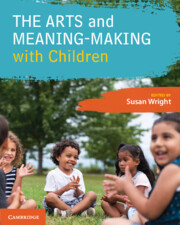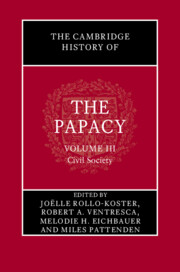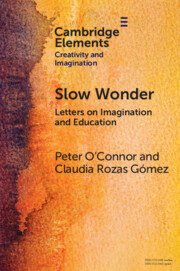Refine search
Actions for selected content:
73 results

The Arts and Meaning-Making with Children
-
- Published online:
- 11 September 2025
- Print publication:
- 25 September 2025
-
- Textbook
- Export citation
Introduction
-
- Book:
- Teaching the Arts
- Published online:
- 28 July 2025
- Print publication:
- 06 August 2025, pp 1-2
-
- Chapter
- Export citation

Teaching the Arts
- Early Childhood and Primary Education
-
- Published online:
- 28 July 2025
- Print publication:
- 06 August 2025
-
- Textbook
- Export citation
Intimate Archives and Anterooms
-
- Journal:
- The Journal of African History / Volume 66 / 2025
- Published online by Cambridge University Press:
- 18 June 2025, e5
-
- Article
-
- You have access
- Open access
- HTML
- Export citation
10 - Learning in and through the arts
-
- Book:
- Intentional Practice with Infants and Toddlers
- Published online:
- 17 June 2025
- Print publication:
- 12 June 2025, pp 255-281
-
- Chapter
- Export citation

The Cambridge History of the Papacy
-
- Published online:
- 28 February 2025
- Print publication:
- 20 March 2025
Chapter 7 - A Once and Future Developmental Psychologist
-
-
- Book:
- Pillars of Developmental Psychology
- Published online:
- 14 February 2025
- Print publication:
- 20 February 2025, pp 68-78
-
- Chapter
- Export citation
“How Our Heritage is Looted”: Legal Meaning-Making, Cultural Property, and Customs Enforcement in Nigeria, 1938–79
-
- Journal:
- The Journal of African History / Volume 65 / Issue 3 / November 2024
- Published online by Cambridge University Press:
- 13 November 2024, pp. 295-309
-
- Article
-
- You have access
- Open access
- HTML
- Export citation
An Interview with National Leaders in the Arts and Humanities
- Part of
-
- Journal:
- Public Humanities / Volume 1 / 2025
- Published online by Cambridge University Press:
- 04 November 2024, e6
-
- Article
-
- You have access
- Open access
- HTML
- Export citation
Plastic pollution and environmental education through artwork
-
- Journal:
- Cambridge Prisms: Plastics / Volume 2 / 2024
- Published online by Cambridge University Press:
- 22 April 2024, e9
-
- Article
-
- You have access
- Open access
- HTML
- Export citation
11 - Early learning for sustainability through STEAM
- from Part 1
-
-
- Book:
- Young Children and the Environment
- Published online:
- 05 January 2024
- Print publication:
- 05 January 2024, pp 234-252
-
- Chapter
- Export citation
Chapter 5 - Exhortation to the Study of Medicine
- from Part II - Case Studies
-
- Book:
- Medicine and Practical Ethics in Galen
- Published online:
- 14 December 2023
- Print publication:
- 04 January 2024, pp 95-123
-
- Chapter
-
- You have access
- Open access
- HTML
- Export citation
6 - Neo-Slave Imaginaries
- from Part II - African American Genres
-
-
- Book:
- The Cambridge Companion to Contemporary African American Literature
- Published online:
- 14 December 2023
- Print publication:
- 21 December 2023, pp 115-127
-
- Chapter
- Export citation
1 - Classical Foundations
- from Part I - What is Rhetoric?
-
- Book:
- Political Rhetoric in Theory and Practice
- Published online:
- 02 November 2023
- Print publication:
- 16 November 2023, pp 11-23
-
- Chapter
- Export citation
Chapter 6 - The Pleasure of Thinking in Diverse Experiences
-
- Book:
- The Pleasure of Thinking
- Published online:
- 05 October 2023
- Print publication:
- 19 October 2023, pp 164-183
-
- Chapter
- Export citation
Chapter 9 - Discipline Creativity
- from Part II - Education
-
- Book:
- Encouraging Innovation
- Published online:
- 17 August 2023
- Print publication:
- 31 August 2023, pp 103-113
-
- Chapter
- Export citation
Chapter 11 - Sexual Intimacy in Black Heterosexual Couple Relationships: Challenges and Opportunities toward Relational Intimacy
- from Part IV - Sex and Intimacy
-
-
- Book:
- Black Couples Therapy
- Published online:
- 27 July 2023
- Print publication:
- 10 August 2023, pp 255-272
-
- Chapter
- Export citation
The Teachings of Mistle Thrush and Kingfisher
-
- Journal:
- Australian Journal of Environmental Education / Volume 39 / Issue 3 / September 2023
- Published online by Cambridge University Press:
- 02 May 2023, pp. 293-306
-
- Article
-
- You have access
- Open access
- HTML
- Export citation
Performing the Struggle Against Apartheid - Opposing Apartheid on Stage: King Kong the Musical By Tyler Fleming. Rochester, NY: University of Rochester Press, 2020. Pp. 428. $130.00, hardcover (ISBN: 97815804698520); $65.00, e-book (ISBN: 9781787446564)
-
- Journal:
- The Journal of African History / Volume 64 / Issue 1 / March 2023
- Published online by Cambridge University Press:
- 20 February 2023, pp. 129-131
-
- Article
- Export citation

Slow Wonder
- Letters on Imagination and Education
-
- Published online:
- 23 September 2022
- Print publication:
- 27 October 2022
-
- Element
- Export citation
